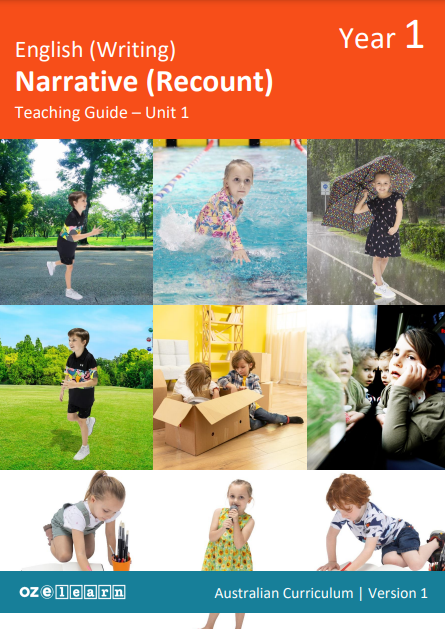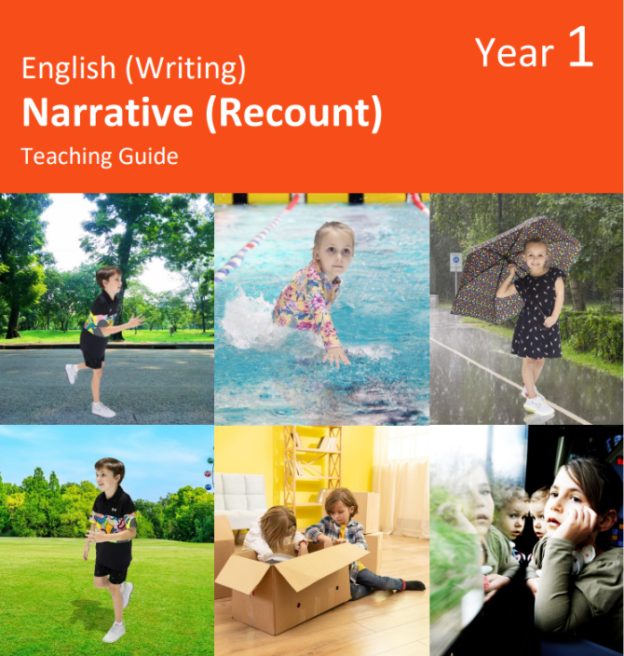Unit 1: Narrative (Recount) Year 1
Oz-e-Writing

Overview
Oz-e-writing Year 1 Narrative (Recount) Unit 1 is a writing unit for Year 1 students. It aligns to the Australian Curriculum V9.0.:
- AC9E1LA03 – Explore how texts are organised according to their purpose, such as to recount, narrate, express opinion, inform, report and explain.
- Discussing and comparing the purposes and organisation of familiar texts.
- AC9E1LA06 – Understand that a simple sentence consists of a single independent clause representing a single event or idea.
- Knowing that a single event or idea can include a process, a happening or a state (verb), the participant or who or what is involved (noun group/phrase), and the surrounding circumstances (adverb group/phrase).
- AC9E1LA07 – Understand that words can represent people, places and things (nouns, including pronouns), happenings and states (verbs), qualities (adjectives) and details such as when, where and how (adverbs)
- Understanding that words or groups of words can represent the participants (nouns; for example, people, places, things) that are involved in various activities or processes.
- AC9E1LA09 – Recognise the vocabulary of learning area topics.
- Identifying words for topics studied at school.
- AC9E1LA10 – Understand that written language uses punctuation such as full stops, question marks and exclamation marks, and uses capital letters for familiar proper nouns.
- Identifying different sentence boundary punctuation, when reading.
- Identifying and using capital letters to name places and holidays.
- AC9E1LY02 – Use interaction skills including turn-taking, speaking clearly, using active listening behaviours and responding to the contributions of others, and contributing ideas and questions.
- Participating in informal and structured class, group and pair discussions about content area topics, ideas and information.
- AC9E1LY06 – Create and re-read to edit short written and/or multimodal texts to report on a topic, express an opinion or recount a real or imagined event, using grammatically correct simple sentences, some topic-specific vocabulary, sentence boundary punctuation and correct spelling of some one- and two-syllable words.
- Applying emerging knowledge of text structure and grammar when creating text.
- Using learning area vocabulary when creating text.
- AC9E1LY08 – Write words using unjoined lower-case and upper-case letters.
- Continuing to develop a functional pencil grip/grasp.
Success Criteria
- Students say and read recounted events. Students draw a recounted event.
- Students say and read recounted events. Students cut and paste and create a recount sentence.
- Students say and read recounted events. Students trace a recount sentence with correct punctuation, letter formation, left to right sweep and functioning pencil grip.
- Students learn grammatical names, meaning and function of nouns, verbs and pronouns within a sentence.
- Students make up and jointly write recount sentences based on an exemplar sentence.
- Students engage in discussion of personal past events and use verbs in the past tense.
- Students say, compose and independently write recount sentences based on an exemplar sentence.
- Students demonstrate, understand and apply simple punctuation. Capital letters and full stops.
Learning objectives
In lessons 1 to 45, students learn:
- Word order in sentences is important for meaning.
- Relationship between words in a sentence. Syntax.
- Verbs in the past tense for recount speaking, reading and writing.
- Grammatical terminology and function: verb, noun and pronoun.
- Read extended recount sentences with phrases of time and attribute.
- Recognise the importance of images in relaying meaning.
- Identify and read words used to describe everyday personal experiences.
- Recognise the role of capital letters and the function of basic punctuation. Apply to own writing.
- Use drawing and writing to express ideas.
- Discuss and compare sentences connected to their personal experiences.
Teaching resources
- lessons
- Teaching Guide
- Student Wordbank
- Student Workbook
- Student Assessment Workbook.
Assessment
At Year 1 level, students’ progress over the unit can be marked using an A–E achievement scale. The Assessment Rubric is referenced to the Year 1 level achievement standard in the Australian Curriculum 9.0. It incorporates content descriptions and elaborations. Based on evidence teachers make an on-balance judgement to decide which standard of performance the student is achieving. Using the Progress Tests and End of Unit Assessment teachers moderate work and modify the rubric. This will provide qualitive and diagnostic feedback on student learning within the Unit.
A progress test will be completed during week 3 and 6 of the unit. Each progress test will include assessment tasks that will assess the content taught during prior weeks. A mark out of 20 will be awarded to each Progress Test.
End of Unit Assessment is to be conducted at the completion of all lessons. A mark out of 60 will be awarded. APPLE questions and Check for Understanding slides provide teachers with the opportunity to assess student understanding at the time of instruction and to drive classroom discussions.



Responses